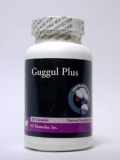| |
Guggul (commiphora mukul) |
|
| Guggul (gum guggul) is a resin produced by the commiphora mukul tree. Commiphora mukul is small, thorny, and usually devoid
of foliage. The mukul tree is related to another tree (Commiphora molmol and C. myrrh) whose bark is the source for myrrh, another gummy substance with healing properties. It grows naturally throughout India and Arabia. Guggul has been traditionally used in the treatment of osteoarthritis and obesity. It has also been used for cholesterol management and for skin disorders, specifically nodulocystic acne. Guggul resin contains steroids, diterpenoids, alipathic esters, and carbohydrates. The extract isolates ketonic steroid compounds known as guggulsterones. Guggulsterones may help keep LDL cholesterol from oxidizing, thereby promoting healthy arteries. Guggulsterones E and Z, may increase hepatic binding sites for LDL cholesterol, thus increasing LDL clearance. Guggulsterones E and Z act as antagonists at the farnesoid X receptor, allowing more cholesterol catabolism and excretion from the body. Guggulsterones also may increase thyroid hormone levels and the basal metabolic rate, which promotes fat loss and weight loss. Guggul has been recommended for the treatment of arthritis, hypercholesterolemia, nodulocystic acne, and overweight. Guggul also increases the production of thyroid hormones, which lower the levels of serum lipids. The lowering of serum lipids is what consequently decreases the risk of atherosclerosis. |
|
|
|
|
 Guggul Plus combines the Ayurvedic botanical Commiphora mukul with garlic, niacin, and lipase to create a synergistic formula that helps retain healthy levels of blood lipids and supports cardiovascular health. Click here for more information.
Guggul Plus combines the Ayurvedic botanical Commiphora mukul with garlic, niacin, and lipase to create a synergistic formula that helps retain healthy levels of blood lipids and supports cardiovascular health. Click here for more information.